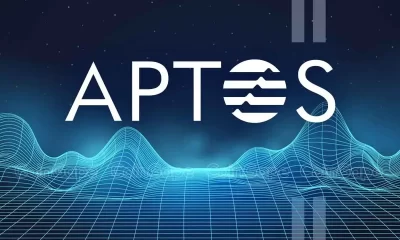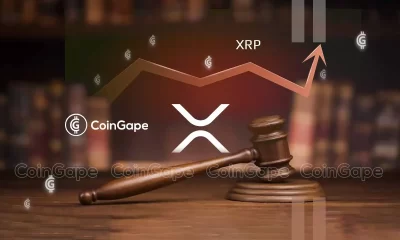Markets
Still ‘Too Early’ to Say Whether Binance Will Return to US, Says CEO Richard Teng
Published
4 months agoon
By
admin

Richard Teng—the CEO of the world’s leading crypto exchange Binance—hinted at the trading platform weighing a return to the United States.
Teng was asked if Binance would look for a way back into the United States or if it might consider launching its Binance USD (BUSD) stablecoin again during a recent Bloomberg interview. “Whether we re-enter the US market, I think that’s a premature discussion,” he said.
Binance has not responded to a request for comment from Decrypt.
The interview follows the reelection of former President Donald Trump in November, who now looks set to make the U.S. far more crypto-friendly. He has already announced a series of pro-crypto regulatory picks to the public.
The vice president-elect, J.D. Vance, holds between $250,000 and $500,000 in Bitcoin, and the Department of Health and Human Services Secretary, Robert F. Kennedy Jr. said that he is “a huge supporter of Bitcoin.” Similarly, national security adviser Michael Waltz voted for pro-crypto bills and holds Bitcoin.
Teng also explained that Binance is largely focused on its “global deployment” and attracting institutions, sovereign wealth funds and wealthy individuals looking “to start allocating to this space.”
The interview follows Binance leaving the U.S. following a $4.3 billion settlement with the Department of Justice. The company was accused of sanctions violations, money laundering and operating as an unlicensed money transmitter.
“I believe that compliance is the way to go,” Teng said. “Given that regulations are going to be much clearer throughout the world, we have the ability to invest very heavily in compliance. I want to make complete compliance a competitive advantage.”
Teng was previously Binance’s global head of regional markets, but took over as the exchange’s CEO in late 2023. At the time, the company’s co-founder and then-CEO Changpeng Zhao had agreed to step down and admitted to having violated United States money laundering laws.
Edited by Stacy Elliott.
Daily Debrief Newsletter
Start every day with the top news stories right now, plus original features, a podcast, videos and more.
Source link
You may like


Elizabeth Warren Calls Stablecoin Bill a Trump and Musk ‘Grift’


Crypto scammers nabbed in India for $700k fraud posing as a Japanese exchange


BTC in Stasis Below $88K as Trump Suggests Bigger Tariffs on EU, Canada


Dogecoin Price Eyes 10x Breakout After Elon Musk Ghibli Anime


XRP Price Rejected at Resistance—Are Bears Taking Control?


OpenAI expects to 3X revenue in 2025 but Chinese AI firms are heating up
Bitcoin
BTC in Stasis Below $88K as Trump Suggests Bigger Tariffs on EU, Canada
Published
2 hours agoon
March 27, 2025By
admin

President Donald Trump has threatened bigger import tariffs against the European Union (EU) and Canada if they worked together “to do economic harm” to the U.S.
“If the European Union works with Canada in order to do economic harm to the USA, large scale Tariffs, far larger than currently planned, will be placed on them both in order to protect the best friend that each of those two countries has ever had!” Trump said in a late Wednesday night post on Truth Social.
Financial markets, however, remain steady in the wake of the new threat, with BTC in stasis below $88,000. Germany’s DAX futures fell 0.3% while their Wall Street counterparts traded flat to positive.
The resilience in the market likely stems from Federal Reserve Chairman Jerome Powell’s recent indication that the inflationary pressures resulting from tariffs could be transitory.
Source link
Markets
Ethereum Volatility Set to Surge in April as Derive Flags Bearish Sentiment Shift
Published
1 day agoon
March 26, 2025By
admin

Ethereum may be entering a period of heightened volatility, according to the latest outlook from decentralized options platform Derive, which sees signs of a breakout despite bearish indicators in the near term.
Nick Forster, founder of Derive, told Decrypt Ethereum’s implied volatility is currently near monthly lows, with 7-day and 30-day tenors sitting at 59% and 45%, respectively.
“Historically, such low levels rarely hold,” he said, adding that April could mark the beginning of a sharp upswing in Ethereum volatility.
Despite the muted volatility, Ethereum’s forward rate—a measure of expected future value—is currently below the U.S. 5% treasury bill rate, signaling weak near-term confidence.
However, Forster said that such conditions have previously preceded price spikes.
“When forward rates are this low, we often see sharp price increases in the following weeks as leveraged positions become more attractive and demand builds,” he said.
Ethereum’s circulating supply on centralized exchanges has fallen to a nine-year low, which could amplify any price reaction if demand rises.
Derive estimates a 30% probability Ethereum will dip below $1,800 by the end of May, but a 19% chance it will rally above $2,500.
Bitcoin remains more stable by comparison, with Derive predicting a 33% chance the asset falls below $80,000 by May and a 20% chance it breaks $100,000.
Meanwhile, other layer-1 tokens are gaining traction. XRP is seeing renewed interest following the SEC’s decision to drop its lawsuit against Ripple Labs, alongside potential ETF applications under review. Derive projects up to $8 billion in inflows if those funds are approved.
Solana is also seeing increased institutional signals, including a Fidelity-registered fund in Delaware that may evolve into a Solana spot ETF.
Ethereum experienced $86 million in outflows last week, compared to $724 million in Bitcoin inflows.
Short-term sentiment may favour Bitcoin, but the Ethereum Foundation’s roadmap, including Etherealize and the Pectra upgrade, could shift institutional attention back to Ethereum in the second half of 2025, Forster said.
Daily Debrief Newsletter
Start every day with the top news stories right now, plus original features, a podcast, videos and more.
Source link
Bitcoin
What Next For XRP, DOGE as Bitcoin Price Action Shows Bearish Double Top Formation
Published
1 day agoon
March 26, 2025By
admin
Bitcoin’s (BTC) recovery looks to have run out of steam with an emergence of a double top bearish reversal pattern on the short duration price charts.
BTC peaked near $87,400 last week, with prices pulling back to around $84,000 on Friday and staging a recovery to above $87,000 before stalling again. This sequence of two prominent peaks at roughly the same level, separated by a trough, hints at a classic double top formation. This bearish pattern often signals the end of an uptrend.

The double top pattern typically requires confirmation through a decisive drop below the “neckline,” the support level between the two peaks, which lies at around $86,000.
Should this occur, BTC could decline toward $75,000 or lower in the short term. However, long-term charts continue to indicate the asset remains in an ascending range.
Traders reacted positively to the U.S. Federal Reserve’s dovish stance on inflation and a cooldown in concerns around the upcoming U.S. tariffs, which have supported gains in the past week.
However, the lack of altcoin correlation with BTC’s recent moves hints that the current price action might lack broad market support, raising the possibility of a “fakeout” rally.
A potential drop in BTC will likely spread over to major tokens, denting recent gains and hopes of a lasting rally. Dogecoin (DOGE), heavily influenced by market sentiment and speculative trading, could see amplified losses if bitcoin’s bearish pattern plays out, while XRP might see reduced momentum, especially given its sensitivity to market sentiment and regulatory developments.
Solana could be particularly sensitive due to its recent volatility and technical indicators — with it coming close to forming a “death cross” (a bearish signal where the 50-day moving average crosses below the 200-day) in mid-April, a pattern that historically leads to deeper losses.
For now, bitcoin hovers in a critical zone. A weekly close below $84,000 could confirm the bearish double top scenario, while a push above $87,500 might invalidate it, potentially reigniting bullish momentum.
Source link

Elizabeth Warren Calls Stablecoin Bill a Trump and Musk ‘Grift’

Crypto scammers nabbed in India for $700k fraud posing as a Japanese exchange

BTC in Stasis Below $88K as Trump Suggests Bigger Tariffs on EU, Canada

Dogecoin Price Eyes 10x Breakout After Elon Musk Ghibli Anime

XRP Price Rejected at Resistance—Are Bears Taking Control?

OpenAI expects to 3X revenue in 2025 but Chinese AI firms are heating up

‘Chart Is Still Broken’ – Crypto Analyst Predicts Sustained Downtrend for Altcoins Until This Takes Place

GameStop Announces $1.3 Billion Fundraising Plan To Purchase Bitcoin

Wyoming Governor Backs Away From State’s Failed Bitcoin Reserve Push

Priced at $0.20, this Solana competitor could be the next crypto to 20x

Why Are We Still Under the SEC’s Gun?

Expert Predicts XRP ETF Approval Is Only A ‘Matter Of Time’ As Approval Odds Soar

Analyst Unveils Extended XRP Price Target To $44, Reveals When To Take Profits

Would GameStop buying Bitcoin help BTC price hit $200K?

New SEC Chair Paul Atkins Holds $6,000,000 in Crypto-Related Investments – Here’s His Portfolio: Report

Arthur Hayes, Murad’s Prediction For Meme Coins, AI & DeFi Coins For 2025

Expert Sees Bitcoin Dipping To $50K While Bullish Signs Persist

Aptos Leverages Chainlink To Enhance Scalability and Data Access

Bitcoin Could Rally to $80,000 on the Eve of US Elections

Sonic Now ‘Golden Standard’ of Layer-2s After Scaling Transactions to 16,000+ per Second, Says Andre Cronje

Institutional Investors Go All In on Crypto as 57% Plan to Boost Allocations as Bull Run Heats Up, Sygnum Survey Reveals

Crypto’s Big Trump Gamble Is Risky

Ripple-SEC Case Ends, But These 3 Rivals Could Jump 500x

Has The Bitcoin Price Already Peaked?

A16z-backed Espresso announces mainnet launch of core product

Xmas Altcoin Rally Insights by BNM Agent I

Blockchain groups challenge new broker reporting rule

Trump’s Coin Is About As Revolutionary As OneCoin

The Future of Bitcoin: Scaling, Institutional Adoption, and Strategic Reserves with Rich Rines

Is $200,000 a Realistic Bitcoin Price Target for This Cycle?
Trending

 24/7 Cryptocurrency News5 months ago
24/7 Cryptocurrency News5 months agoArthur Hayes, Murad’s Prediction For Meme Coins, AI & DeFi Coins For 2025

 Bitcoin2 months ago
Bitcoin2 months agoExpert Sees Bitcoin Dipping To $50K While Bullish Signs Persist

 24/7 Cryptocurrency News3 months ago
24/7 Cryptocurrency News3 months agoAptos Leverages Chainlink To Enhance Scalability and Data Access

 Bitcoin5 months ago
Bitcoin5 months agoBitcoin Could Rally to $80,000 on the Eve of US Elections

 Altcoins2 months ago
Altcoins2 months agoSonic Now ‘Golden Standard’ of Layer-2s After Scaling Transactions to 16,000+ per Second, Says Andre Cronje

 Bitcoin4 months ago
Bitcoin4 months agoInstitutional Investors Go All In on Crypto as 57% Plan to Boost Allocations as Bull Run Heats Up, Sygnum Survey Reveals

 Opinion5 months ago
Opinion5 months agoCrypto’s Big Trump Gamble Is Risky

 Price analysis5 months ago
Price analysis5 months agoRipple-SEC Case Ends, But These 3 Rivals Could Jump 500x


